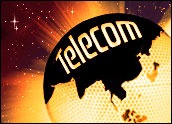
After several disappointing years, the telecom market experienced renewed growth in 2006, and a number of surprising developments occurred. The highlights include the integration of cellular and WiFi features, a rush to deliver mobile music services, movement toward bundled services, a focus on higher speed home networks, and unprecedented acceptance of Voice over Internet Protocol (VoIP).
Cellular services have been one of the prime drivers in this market.
“Passing the 1 billion mark in users worldwide was certainly a significant event for the cellular industry,” said Ira Brodsky, president ofDatacomm Research. In the U.S., the number of wireless users is now greater than the number of customers with wired connections. Partly because of the surge in cellular services, the Telecommunications Industry Association expects double-digit growth this year, with worldwide telecom revenue closing in on the US$3 trillion mark.
Following are five developments that had a major impact on the industry in 2006.
1. Integration of Cellular and WiFi Takes Hold
As wireless networks gain traction, one area of interest is the integration of cellular and wireless services. This integration allows cellular carriers to lessen coverage problems that arise in large buildings or areas that are out of range of local cellular towers. Another plus is that carriers can maximize use of their networks.
The movement to integrated cellular WiFi networks picked up steam in 2006, with Qualcomm’s acquisition of Airgo Networks, an expert in the chipset technology needed to support this integration.
T-Mobile is one company that has rolled out these integrated services, and more carriers are expected to do the same in the next few years.
2. Mobile Music Distribution Gains Traction
The success ofApple’s iPod forced cellular carriers to take a close look at the music download market. Phones that emulate Apple’s iPod and play music became more common:AT&T Wireless offersMotorola’s RokrandVerizon Wireless has been promotingLG Electronics’ Chocolate.
In addition to moving on the handset front, the carriers are trying to beef up their downloading services.
“A lot of the cell phone users are interested in music, and these new downloading services enable them to satisfy their interest,” said Neil Strother, an industry analyst withThe NPD Group.
Cingular Wireless has partnerships with Yahoo,Napster andeMusic, which is owned by Dimensional Associates. With Yahoo and Napster, subscribers pay about $10 to $15 a month to download all the music they want to their phones.
eMusic, on the other hand, charges a monthly fee; the price depends on the number of tunes subscribers download each month.
3. Quadplay Services Emerge
The days of selling a single network service — voice, data or video, for example — are falling by the wayside. In addition to offering voice and broadband data services, telcos have been adding video and wireless services to their product lines. They hope that these packages will reduce churn by tightening the bond to customers.
Also, expanding their product lines offers them a way to lower service pricing: Verizon’s Freedom package combines a customer’s telecommunications,Internet Access, and cable TV charges into one bill, so consumers can save as much as $240 a year with the service.
“The traditional dividing telco lines — local, long distance, Internet access, cable TV — are no longer relevant,” the NPD Group’s Strother told the E-Commerce Times. Consequently, vendors are in a mad rush to broaden their portfolios either via merger or alliance, creating an industry awash in upheaval and uncertainty.
4. New Home-Networking Options Arise
WiFi has become the dominant method for building home networks. “Users are interested in WiFi because these products have been inexpensive to develop, easy to deploy, and popular among many vendors and resellers,” noted Kurt Scherf, a vice president at market research firm Parks Associates.
However, the current 50 Mbps top speed may not be adequate to support video transmissions, and the networking option has lacked quality of service (QoS) functions, which ensure that bandwidth is available to certain applications.
Vendors had been planning to address those limitations with a higher-speed option, the 802.11n standard, which runs at 100 Mbps. Adoption of this standard has been plagued by infighting — so, at the moment, there is no clear cut path to a higher-speed network option, and that has left the door open to alternatives.
The HomePNA alliance has been concentrating on using copper phone lines to carry information through the home. The ubiquity of these outlets has been a lure with this networking option.
Recently, the group enhanced its standard so it promotes the use of existing coaxial cable, as well as copper phone lines, to carry data through the home. AT&T announced it would support that offering as part of its high-speed home-networking initiative. AT&T has been a major supporter of this initiative and has begun rolling out home network services based on it.
Multimedia over Coax Alliance (MoCA) supporters, who include2Wire, Motorola, andWestell Technologies, designed a standard that lets consumers use coaxial cable to move video information from device to device at speeds of up to 270 Mbps.
The initial version of the specification was approved in February 2006, and more than a dozen vendors have had their products or services certified as MoCA compliant. “Verizon has begun aggressively rolling out MoCA services, which is a bit of a surprise,” Parks Associates’ Scherf told the E-Commerce Times.
5. VoIP Moves Into the Mainstream
The movement to VoIP services continues to gain acceptance. This platform enables carriers to deliver next-generation services to customers at low prices.
Skype has been the market leader, with 100 million customers in the middle of 2006 and 150 million expected by year end.
Vonage (NYSE: VG), which has 2 million subscribers, has struggled a bit in building its business. The company was sued bySprint-Nextel, Verizon and Klausner Technologies for patent infringements. Also Vonage’s IPO did not rise as high as hoped, and some customers, who were also able to become shareholders, sued the company.
The VoIP initiatives illustrate one unsurprising development in the telecom market: Some companies read the market well, while others stumble a bit.












































Social Media
See all Social Media